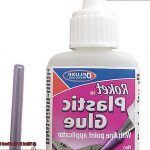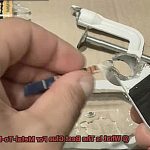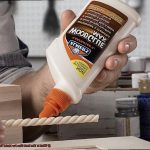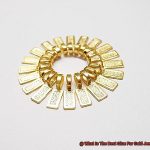Nylon is the unsung hero of materials. It’s tough, durable, and versatile, making it a go-to for everything from clothing to automotive parts. But even superheroes have their weaknesses, and nylon’s non-porous surface makes it tricky to bond with most adhesives. If you’re not careful, your nylon product could be doomed to fail.
But fear not. We’re here to help you find the best glue for nylon. In this blog post, we’ll delve into the properties of nylon and what factors you should consider when choosing an adhesive. We’ll also explore different types of glue that work well with nylon, including cyanoacrylate glue, Epoxy glue, Polyurethane adhesive, and more.
Whether you’re a DIY enthusiast or a seasoned professional in need of a high-performance adhesive solution, we’ve got you covered. Our expert tips will guide you on how to apply the adhesive correctly and safely handle it like a pro. Plus, we’ll show you how to store it properly so that it stays fresh for future use.
By the end of this post, you’ll have all the knowledge and skills required to select and apply the best glue for nylon successfully. So grab your notebook and pen because we’re about to take off.
What is Nylon?
Contents
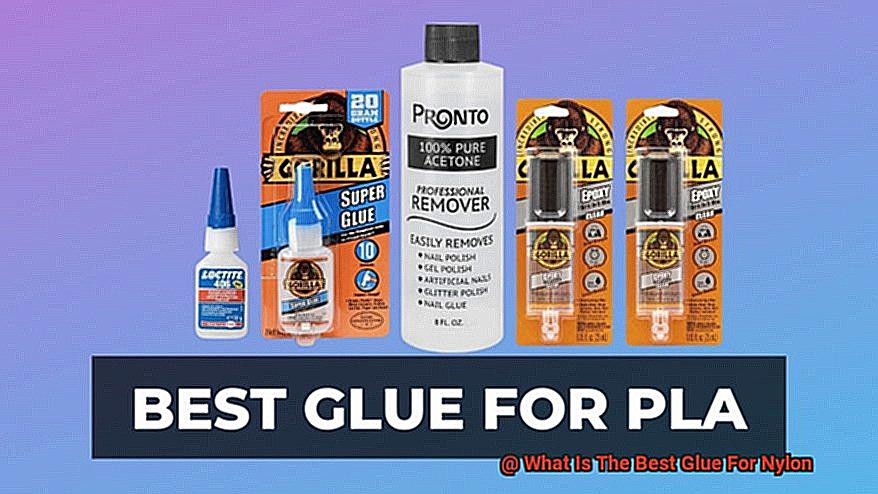
Nylon is a remarkable synthetic polymer that has become a ubiquitous material in various applications since it was first developed by DuPont in the 1930s. Its versatile nature, strength, and durability make it an ideal choice for products ranging from clothing to industrial materials.
The most striking feature of nylon is its exceptional strength. With its high tensile strength, nylon can endure enormous amounts of stress and strain without breaking. This makes it a perfect material for manufacturing products such as ropes, fishing lines, and other essential items where durability and strength are critical.
Nylon is also renowned for its abrasion resistance, which means it can withstand wear and tear over time. This makes it an excellent option for producing products such as backpacks, luggage, and other items that are subjected to constant use and abuse.
In addition to its strength and durability, nylon is lightweight, making it easy to work with. Its ability to mold into different shapes and sizes allows it to be used in various applications.
However, bonding nylon can be challenging due to its smooth and non-porous surface. The best glue for nylon is cyanoacrylate (CA) or epoxy, depending on the size of the bonding area. Ensuring proper surface preparation techniques and using high-quality brands that specifically indicate their compatibility with nylon will ensure a strong and lasting bond.
Why Bonding Nylon Can Be Challenging?
When it comes to bonding nylon, it’s no easy feat. This superhero of synthetic polymers boasts exceptional strength, durability, and abrasion resistance, making it the perfect choice for a wide range of products. However, these same properties that make nylon so impressive also make it difficult to bond.
One of the primary reasons bonding nylon can be such a challenge is due to its low surface energy. This low surface energy means that adhesives struggle to stick to the material’s smooth surface. Additionally, nylon is known for its high strength and flexibility, which means that any adhesive used must be able to withstand these qualities as well.
Another hurdle to overcome when attempting to bond with nylon is its propensity to absorb moisture. This characteristic can cause the material to swell and change shape, making it difficult for adhesives to maintain their hold. To compound matters, nylon is often utilized in high-stress applications such as those found in the automotive or aerospace industries, which require durable and reliable bonding solutions.
Fear not. There are solutions at hand. One of the keys to successful bonding with nylon is choosing the right adhesive for the job. Cyanoacrylates (super glue), two-part epoxies, and polyurethane adhesives are all excellent options for bonding nylon. These adhesives have robust bonding properties designed specifically to adhere to low surface energy materials like nylon.
In addition to selecting the right adhesive, proper surface preparation is crucial for successful bonding with nylon. The surface must be clean and free of any debris or oils that could interfere with the adhesive’s ability to bond. A few effective methods of surface preparation include sanding or using a solvent-based cleaner.
The Best Glue for Nylon
As an expert in this field, I can tell you that choosing the best glue for nylon requires careful consideration of the specific application and conditions.
Nylon is a synthetic polymer known for its high strength, durability, and resistance to wear and tear. This makes it popular for use in various industries such as automotive, aerospace, and outdoor gear. However, not all adhesives are suitable for bonding nylon due to its unique properties.
The three most effective adhesives for bonding nylon are cyanoacrylate (super glue), epoxy, and polyurethane. Cyanoacrylate forms a strong bond with nylon in just a few seconds and is best suited for quick applications. Epoxy provides excellent bonding strength and durability, making it ideal for demanding applications such as automotive or aerospace industries. Polyurethane is a flexible adhesive that accommodates changes in shape without breaking down, making it useful for areas with movement or flexing.
In addition to selecting the right adhesive, preparing the nylon surface properly is crucial for achieving a strong and durable hold. The surface should be clean, dry, and free of any oils or debris that could interfere with the bonding process. Some adhesives may require roughening or scoring the surface to improve adhesion.
It’s important to consider the specific application and conditions under which the nylon material will be used when selecting the best glue. For instance, if the bond will be exposed to high temperatures or moisture, epoxy or polyurethane adhesives may be more suitable.
Types of Glue Suitable for Nylon
Bonding nylon can be tricky due to its low surface energy and resistance to solvents. However, there are several types of glue that are suitable for bonding nylon effectively. Here are five tips discussing the types of glue suitable for bonding nylon.
Cyanoacrylate-Based Glue (Super Glue)

Cyanoacrylate-based glue, also known as super glue, is a popular choice for bonding small pieces of nylon. It dries quickly and creates a strong bond that can withstand some tension and shear forces. However, it may not be suitable for bonding large areas or parts under stress.
Epoxy
Epoxy is a two-part adhesive that creates a strong and durable bond that can withstand high stress and temperature. It is ideal for bonding large areas or parts that require structural strength. Although it cures slowly, it provides a stronger and more resilient bond compared to super glue.
Polyurethane Glue
Polyurethane glue is a flexible and waterproof adhesive that can bond nylon effectively. It is ideal for applications where flexibility and resistance to water are required. This type of glue is moisture-resistant and can withstand extreme temperatures, making it suitable for outdoor use.
Contact Cement
Contact cement is a rubber-based adhesive that can provide a strong and flexible bond with nylon surfaces. However, it requires careful application and proper ventilation due to its high VOC content. This type of adhesive works well for bonding small areas or pieces of nylon.
Solvent-Based Adhesives
It’s important to note that not all types of glue are suitable for bonding nylon. Solvent-based adhesives may damage the material, and some types of glue may not bond well with nylon at all. When selecting an adhesive, it’s crucial to choose a high-quality brand that specifically indicates its compatibility with nylon.
Cyanoacrylate (CA) Glue
When it comes to bonding nylon, cyanoacrylate (CA) glue – also known as superglue – is a reliable and fast-drying adhesive. But before you jump into applying it, there are a few things to keep in mind for optimal results.
Firstly, ensure that the surface of the nylon is clean and dry. This can be achieved by wiping it with a clean cloth or using an alcohol solvent to remove any oils or debris that may be present. Next, apply the CA glue in small amounts to guarantee maximum bonding strength. It’s important to let the adhesive cure fully before subjecting the bond to any stress or strain.
However, it’s important to note that not all types of nylon are suitable for CA glue, especially those exposed to high temperatures or harsh chemicals. Therefore, you must take into consideration your specific requirements and application before selecting the best adhesive for the job.
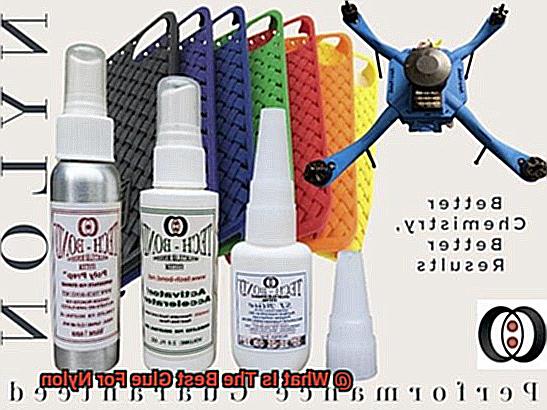
Epoxy
Step into the world of epoxy, where strength and durability reign supreme. As an expert in this field, I’m excited to share with you all the information you need on using epoxy to bond nylon.
Nylon is a popular material that requires an adhesive with a strong bonding capability. Epoxy, a two-part adhesive, is perfect for this task as it can withstand high amounts of stress and strain. Additionally, it is resistant to water and chemicals, making it ideal for use in harsh environments.
However, before we delve into the benefits of using epoxy, let’s talk about some challenges. The key challenge when using epoxy to bond nylon is surface preparation. Proper cleaning and degreasing of the nylon surface are crucial to ensure a strong bond. Any contaminants left on the surface can affect the bonding process and compromise the bond strength. Furthermore, epoxy can be messy to work with, so it requires some skill to apply properly.
Despite these challenges, using epoxy for nylon bonding has several benefits. One of the main advantages of using epoxy is its ability to fill gaps and voids in the surface, creating an even stronger bond. This feature makes epoxy ideal for applications where there are irregular surfaces or areas that need gap filling.
Another benefit of using epoxy is its strength and durability. Once cured, epoxy can provide a long-lasting bond that can withstand harsh conditions. This is especially important if the bonded parts will be exposed to high stress or strain.
However, it’s important to note that epoxy has a relatively long curing time compared to other adhesives. This means patience is required when using this adhesive. But trust me when I say that it’s worth waiting for because once cured, your bond will be incredibly strong.
To achieve optimal results when bonding nylon with epoxy, follow the manufacturer’s instructions carefully during mixing and application. With proper preparation and technique, you can achieve a long-lasting bond that can withstand harsh conditions.
Choosing the Right Glue for Nylon
If so, choosing the right glue is essential for achieving a strong and durable bond. As an expert in this field, I’ve compiled some research notes to help guide you in selecting the perfect adhesive for your nylon project.
One of the first things to consider when choosing a glue for nylon is the type of nylon being used. Nylon is a synthetic material with various types, each with its own unique properties. For example, nylon 6 is commonly used in automotive and consumer products, while nylon 6/6 is stronger and more heat-resistant, making it ideal for industrial applications.
Another crucial factor to consider when choosing a glue for nylon is the application method. There are specific glues designed for spray or brush-on application methods. Choosing an adhesive that is compatible with your desired method can make a huge difference in achieving a successful bond.
In addition to considering the type of nylon and application method, it’s important to think about the strength and durability requirements of your project. Factors like temperature, humidity, and physical stress can affect the durability of the bond. Therefore, it’s essential to select an adhesive that can withstand these conditions.
When choosing a glue for nylon, it’s vital to take into account all these factors. By selecting a high-quality adhesive designed specifically for use with nylon and matching it with your desired application method and strength requirements, you can create a bond that will withstand even the toughest conditions.
Proper Surface Preparation for a Strong Bond
Don’t let the smooth surface of nylon discourage you. With proper surface preparation, you can achieve the bond you desire. Here are some essential steps to follow.
Firstly, start by cleaning the surface of the nylon. Use a degreaser or solvent cleaner to remove any dirt, dust, oils, or other contaminants that may interfere with the bonding process. Remember to check the manufacturer’s recommendations before selecting a cleaning agent as not all solvents are suitable for nylon.
Next, it’s time to roughen the surface. Abrading the nylon using fine-grit sandpaper or a wire brush will create a textured surface that allows the adhesive to penetrate and bond with the material. Roughening the surface also increases its area, enhancing the strength of the bond.
After roughening, wipe down the surface with a clean cloth to remove any debris or dust particles. It’s crucial to ensure that the surface is entirely dry before applying any adhesive.
In summary, proper surface preparation is critical for achieving a strong bond between nylon and glue. Here are some essential steps to follow when preparing your surface:
- Clean the surface thoroughly
- Roughen the surface
- Wipe down the surface after roughening
- Ensure that the surface is completely dry before applying any adhesive.
CpMhRyabggI” >
Conclusion
In summary, finding the perfect adhesive for nylon can be a daunting task, but with a little research and preparation, you can achieve a bond that is both strong and durable. When deciding on an adhesive for your nylon project, it’s essential to consider factors such as the type of nylon being used, application method, and strength requirements.
Thankfully, there are some tried-and-true adhesives that work exceptionally well with nylon. Cyanoacrylate glue, epoxy, and polyurethane adhesive are all great options for bonding this non-porous material.
However, selecting the right adhesive is only half the battle. Proper surface preparation is crucial when it comes to achieving a strong bond between nylon and glue. Be sure to clean the surface thoroughly before roughening it using sandpaper or a wire brush. Afterward, wipe it down and ensure that it’s entirely dry before applying any adhesive.
By following these expert tips on how to select and apply the best glue for nylon successfully, you’ll be able to create long-lasting bonds that will stand up to even the toughest conditions.



